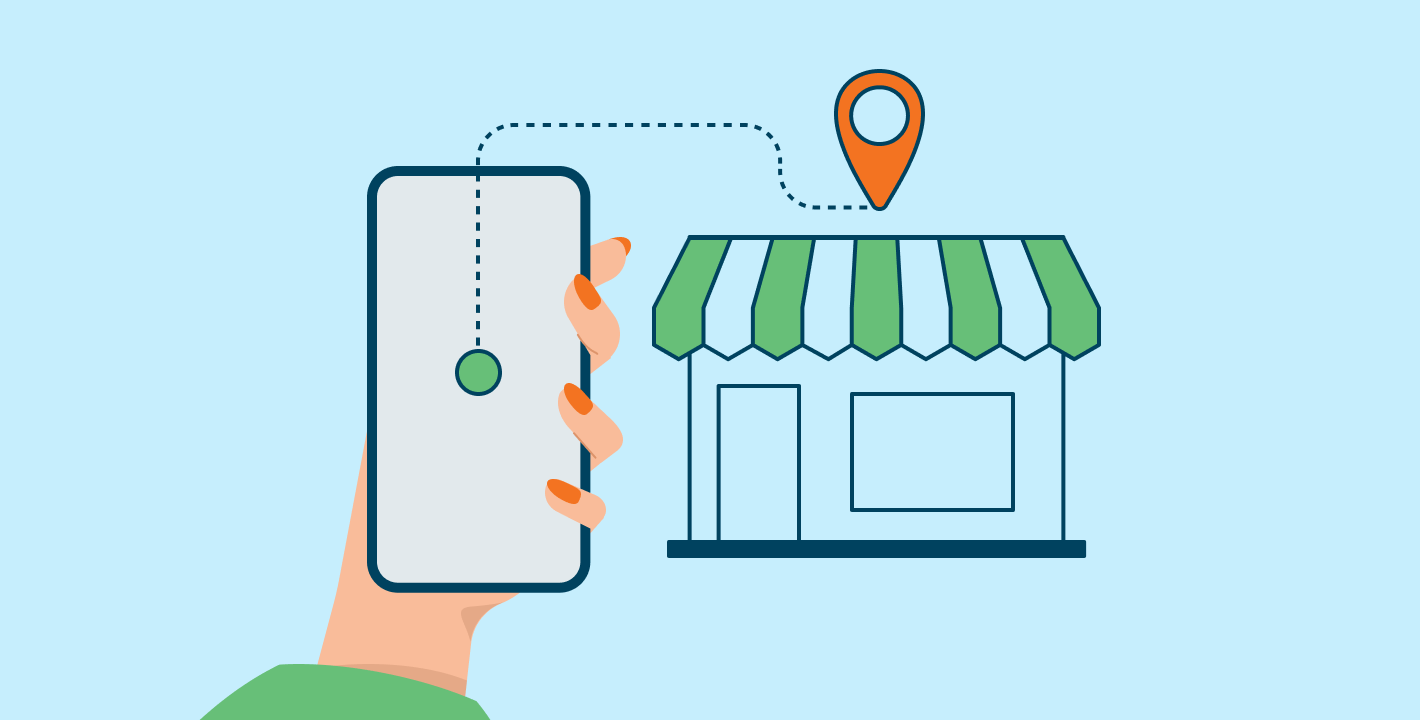Target the Right Customers with Hyperlocal Social Media Marketing
Local businesses have generally relied on word-of-mouth marketing in their tight-knit communities. While that’ll never go out of style, there’s another avenue to promote your business on social media without letting distance get in the way.
With hyperlocal social media marketing, you can focus on the right audience near you. All you need to do is use it effectively to reach consumers in your immediate area.
In this article, you’ll learn what hyperlocal social media marketing is, how it works, and how to use some top strategies to push your local business into the limelight.
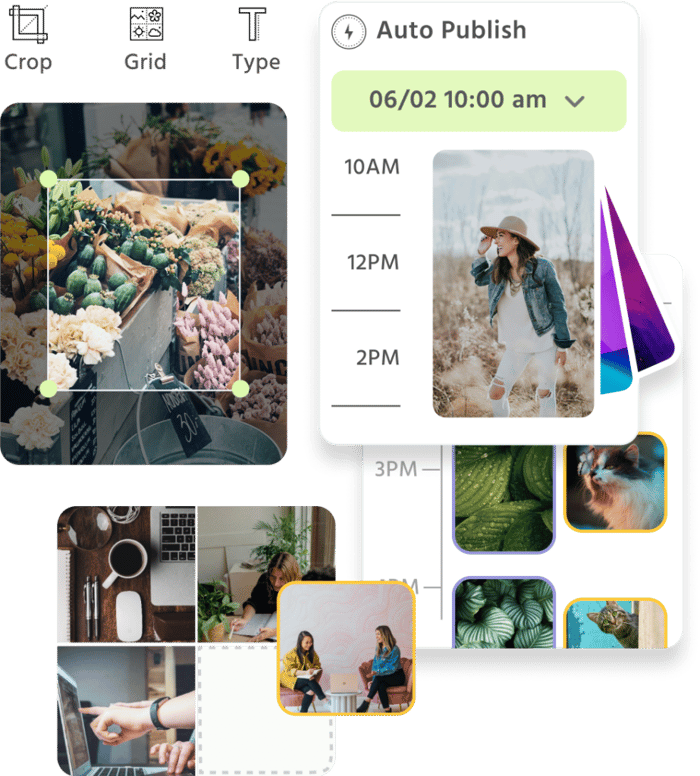
Manage all your social media accounts in one place.
Craft, schedule, & auto-post content to all your social channels, then track analytics and manage interactions from a single, easy-to-use dashboard.
What’s hyperlocal social media marketing?
Local search is important, especially since 69% of digital traffic is through organic search and local, with over 22% attributed to local traffic alone. Knowing that it’s crucial not to underestimate the potential of social search. Social media is the place that users go for product discovery. Regardless of generation or demographics, 57% of users report jumping on social media platforms to learn about a brand, product, or service.
Hyperlocal social media marketing is a strategy that uses social media platforms to bring in consumers based in a specific geographical location. It’s best for small, local businesses like cafes, restaurants, independent bookstores, and hair or nail salons.
For example, a brand with multiple local stores might focus on a specific location and post it by geotagging that city while also providing local options for delivery. Alternatively, it may also use hyperlocal marketing to announce a new opening in a neighborhood.
Many people see social media as a way of attracting attention across larger populations, usually for a major business or an online brand, but that isn’t always the case. The more hyperspecific your marketing is, the more awareness your business profile can generate. By targeting social SEO and ad campaigns to a niche in your area, you can prevent high-converting users from getting lost among broad audiences.
Not only does hyperlocal social media marketing offer a high return on investment, but it’s also a way to connect with and keep locals updated with your promotions, events, and products, alongside many other benefits.
Benefits of hyperlocal social media marketing
Hyperlocal social media marketing targets a specific, local audience, thus offering the following advantages.
- Enhanced content personalization and relevance: Identifying your target audience’s unique aspects helps you create content that resonates with them. Understanding the locale’s primary demographics, interests, and cultural background can help build a content strategy that accurately represents your ideal customer.
- Improved customer relationships: Social media allows any business, small or large, a closer relationship with its potential and recurrent customers. It’s a direct way to communicate with locals and engage with them in a two-way interaction.
- Strengthened community ties: Social media allows you to create a tighter-knit community by highlighting local landmarks and businesses and sharing information about local attractions. Establishing yourself in the community is possible by connecting with local consumers and other businesses near them.
- Increased conversion rates: Focusing on a highly specific location allows you to best tailor your social media content to the right audience, which leads to increased foot traffic. For local businesses, this might mean making a local order in reaction to your promotion or heading to the store right away to make a purchase.
- Reduced ad spend: Hyperlocal social media marketing allows businesses to reduce their ad spend because the ads are so targeted they catch the right audience’s attention. This leads to fewer wasted ads, thus optimizing your ad budget.
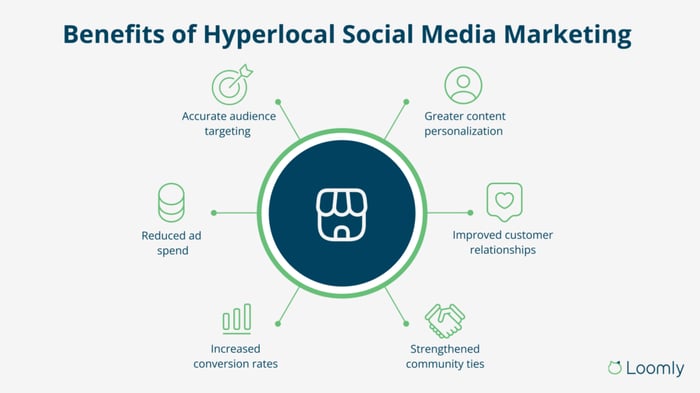
How hyperlocal social media marketing works
Most people who search for local-related keywords have a high purchasing intent. These “near me” searches are from easy-to-convert consumers and, as such, are less competitive SEO-wise.
Moreover, over 24% of consumers aged 18-54 look for businesses on social media more often than through a search engine, with 36% in Gen Z. So targeting near-me searches on social media by optimizing your content and profile for a locale is a no-brainer.
Knowing your audience is the first step to creating a hyperlocal social media marketing strategy. Understand your audience best by identifying the geographic area, neighborhood, or locality. Naturally, this means knowing demographics. Location can tell you a lot about what your target audience is interested in, like local events, culture, trends, activities, interests, and preferences.
For example, if you are a local business or a franchise in a historically ethnic neighborhood like Chicago’s Latin-American Pilsen or Washington, DC’s Little Ethiopia, it’s important to identify cultural traditions. These can inform your social media posts and announcements. You might participate in holidays like Cinco De Mayo or the Lunar New Year by announcing a sale on social media.
It also helps to know your competitors in the locale. This way, you can target consumers at the competitor’s store location.
Creating hyperlocal marketing strategies requires knowing the inner workings of local settings on social media. Each platform has its own parameters and opportunities to improve your campaign.
Hyperlocal marketing on various social media platforms
To figure out which social media platforms work best for you, here’s a rundown of how each site offers optimization options for hyperlocal marketing.
- Facebook offers a slew of features targeting options for specific demographic areas. You can also get closer to your community by creating groups or connecting with and promoting via local groups and events pages.
- Instagram is a platform for multimedia content like stories and reels for brand awareness. It’s also a great place to connect with local users through localized tagging, hashtags, and location tags.
- Twitter (recently rebranded as ‘X’), while not the go-to platform for local businesses, does offer the opportunity to use hashtags, location tags, and advanced search features to reach the right audience.
- TikTok includes settings to target audiences in specific locations and geotagging and locale-based hashtags.
- Google Business Profile offers a free profile for your business so users can find you on Google, show what you offer, and improve keywords.
- LinkedIn allows you to reach out to other local businesses or businesses in the same location and join community groups and events. Learn more about LinkedIn marketing.
- Pinterest enables you to optimize your profile and posts with your location and local keywords so that they meet the right audience. Create boards linking to other content (blog posts, etc.) or engaging videos. With Loomly, you can schedule and auto-post videos on Pinterest.

How to implement a hyperlocal social media marketing strategy
Here are some keystone techniques you can use to target hyperlocal audiences on social media.
Local hashtags and geotags
Several ways exist to take advantage of a social platform’s local SEO. You can tag locale-based aspects in each post, story, video, etc. Location-based hashtags increase the visibility of your content so that local users familiar with those landmarks can easily find you. For example, a donut shop might urge users to grab a treat and coffee on their way to see the local museum or historical site.
Another tip is to tag or highlight local events. For this, you’ll have to keep up with national and local events by posting relevant content and tagging them.
With hyperlocal paid advertising, make sure they’re geo-location-targeted ads. These ads on social media sites only target users within a set radius of the business location. Social media platforms allow for some variation of geo-location ad settings, allowing for a better conversion rate.
Otherwise, non-paid geotagging is also possible. It’s a way to tag a Google Maps location or coordinates on images, videos, or other multimedia metadata.
Create listings in small business directories
Countless small business directories are available to use for free to optimize your search rankings. Your Google My Business (GMB) profile should be your first stop since it’s directly connected to Google’s location-based search results.
A good profile opens the doors to greater visibility, reviews, and even user-generated content by customers who can upload pictures of your business. You can optimize your profile (for free) by adding a description, images, and links to your social media profiles. Social media management tools like Loomly have a Google My Business integration to help manage your profile. Another option is to show local search ads on Google Maps to bring users searching for relevant keywords to your GMB profile.
Other databases include Yelp, BetterBusinessBureau, Nextdoor, and more.
Geofencing is another aspect of hyperlocal marketing to consider. Essentially, it is data-driven technology that most social media sites include to trigger actions or ads when users are near the target geographical radius around your locale. When users often get a notification to review a place or event they’ve just been in, that’s geofencing at work.
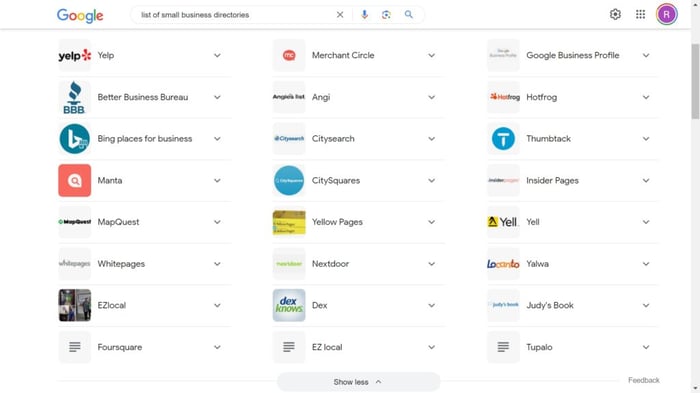
Community engagement
For 2023, 90% of social media marketers say that nurturing an online community is one of the keys to success. Engaging with your followers is a sure way to grow them and stay afloat in the social media algorithm. Include giveaways or contests encouraging customers to tag your business in their posts.
You can also encourage customers to post photos on social media and tag your business, creating the opportunity to repost the user generated content. Partnering with local influencers is another great way to drive engagement on social media.
Cross-promote with other local businesses
Social media opens the doors to cross-promotion. One of the best ways to do this is to seek opportunities to engage with other local businesses. Think about the businesses in your area, and make yourself known in their comments. Build partnerships to cross-promote — each business posts content that markets the other.
Another way to embed yourself in the online local community is to ask local community groups to cross-promote. Every city or neighborhood tends to have a group online that promotes small businesses, groups dedicated to local eateries or cafes, or other industries for users to find desired services in their area.
Here’s an example of how the Austin Wildlife Rescue partnered up with Wheatsville Food Co-op, Austin’s Community Grocery Store. Wheatsville promoted the wildlife rehab center on its post while announcing the release of its Activity Book at store locations (around Austin).
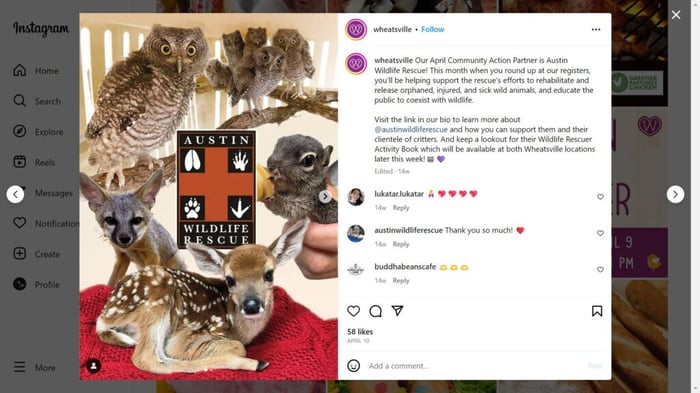
Create highly tailored social media content
Once you have homed in on your local audience, you should have enough information to churn out relevant content. As a part of any hyperlocal marketing strategy, regular content posting is essential, providing opportunities to be found in key tags.
Post often and consistently. How often might depend on your strategy, but once a week should be the minimum. To do this, a posting schedule and plan will do the trick, so creative burnout remains far away. Tools like Loomly can help plan your content strategy and brainstorm ideas for weeks to come. It also lets you auto-post all sorts of content across various social platforms.
As for content ideas, research your industry to see key trends and best practices. According to Kim Garst, consider the top questions your ideal customer might ask and start with at least ten pieces of evergreen content to answer those questions. Other posts might piggyback off those principal content pieces. Use your locale to guide your content by weaving in relevant elements like inside jokes only people from that area might understand or local news.
Below, the Elliott Bay Book Company’s Facebook page posted some book recommendations based on a major trend in 2023 — the release of the Barbie movie. Notice that they have a strong understanding of their target audience — Gen Z and Millennial users in online book communities who are more likely to support independent bookstores.
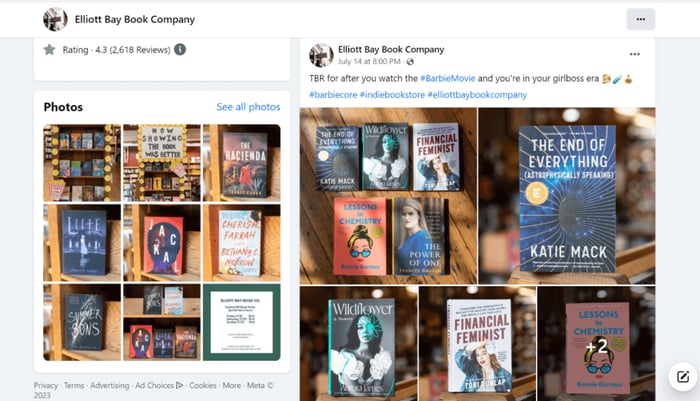
Conclusion
Hyperlocal social media marketing is essential for small businesses to increase foot traffic. Most, if not all, social media platforms include many opportunities to target by location (for free!), and using them can only push your campaign forward. Building a hyperlocal social media marketing strategy is key to reducing your ad spend and improving your relationship with your community. That means using neat hacks like geotargeting and personalizing your content to your local audience.
It doesn’t have to be complicated. Keeping up with your social media content strategy is easy with tools like Loomly, which you can use to create, optimize, and plan your social marketing content. Try Loomly today to reach customers near you.
